![]()
![]()
![]()
Use LEFT and RIGHT arrow keys to navigate between flashcards;
Use UP and DOWN arrow keys to flip the card;
H to show hint;
A reads text to speech;
73 Cards in this Set
- Front
- Back
|
Alms |
Donations, usually food given by the the laity to ascetics. |
|
|
Aryans |
Race which invaded India in ancient times and established themselves as the dominant('noble') class of society. |
|
|
Ascenticism |
A religious practice of self-denial and even inflicting pain on oneself. |
|
|
Atman(s) |
The eternal soul or self in Hindu belief. |
|
|
Bodhi(s) |
Awareness, enlightenment. |
|
|
Bodhi Tree (Bo Tree) |
The type of tree under which the Buddha was said to have become enlightened, otherwise known as the pipal tree. It has distinctively shaped leaves. |
|
|
Bodhisattva/ Bodhisatta |
'One who has the essence of enlightenment'
1) A person who will become a Buddha in the future.
2) one who puts off ultimate enlightenment until all other beings are saved (in contrast who takes off Nibbana by themselves) |
|
|
Angulimala |
A story teaching anyone can be enlightened no matter what you have done and that it is never too late. Also shows that reforming people is more effective than punishment.
Summary: The Buddha found a village deserted and no one wanted to pass through because a mass murderer was on the lose. He had cut of a finger of each of his victims and wore 99 fingers around his neck( hence his name 'necklace of fingers').
The Buddha when though anyway. He then heard footsteps from behind him and the murderer demanded he stop but the Buddha continued walking. When he caught up he asked why he didn't stop and the Buddha told him 'I stopped a long time it's you who has not'.
Angulimala was confused and blocked his path and forced him to stop. When he did the Buddha looked him straight in the eye like a friend or a brother. The two engaged in conversation and he explained that he had learnt how to stop hurting others and he asked why should if other humans are hurtful.
The Buddha told him just as there are hurtful people there are also caring people. He told him 'Right now you are on the path of hatred, but it is up to you: you can choose the path of love and forgiveness instead'.
He knew the Buddha was speaking the truth but thought that he had gone too far and could no longer turn back.
The Buddha told him it was never too late.
Angulimala eventually dropped to his knees and vowed to change his evil ways and to follow him. He was ordained as a monk and lead a disciplined life. Even the Buddha was amazed at his speed of transformation and just after 2 weeks he radiated serenity and stability, and the other monks nicknamed him 'Ahimsaka', which means 'non-violent one'. |
|
|
Sunita |
A story teaching that it doesn't matter what you are or your status you are able to become enlightened and that anyone is allowed to follow the Buddha. Summary: Sunita was a homeless 'untouchable' who survived by sweeping the streets. It was custom for the low-caste people like him to stand at a distance from anyone of high caste who might approach. One day while his was sweeping the road, he saw the Buddha approaching with a group of monks. He looked on vain for a place to stand aside from them, bit the best he could do was flatten himself against a wall and fold his hands in a gesture of respect. To his dismay the Buddha came up to him, but far from being angry with him, as he had expected, the Buddha spoke to him in a friendly way. He asked Sunita if he would like to give up his job as a sweeper and follow him instead. Sunita was astonished and delighted as he was used to being ordered around; nobody had ever spoke to him kindly before. He jumped at the chance and the Buddha ordained him there and then. In time he became a respected and educated monk. |
|
|
Devadatta |
Teaches that no matter how much wrong doing you do or how much you hurt the Buddha, he will always forgive you and will never abandon you from the Buddhist community as they are always open to anyone and everyone. Summary: Devadatta was the Buddha's jealous cousin. They grew up together and as an adult he became a monk and follower of the Buddha. Devadatta was jealous of the Buddha and orchestrated 3 association attempts as well as attempt to create a split in the Buddhist community, but he ultimately called to covert everyone around him. First, he hired assassins to kill him, but they were moved by the Buddha's persuasiveness and became converts instead. Second, Devadatta climbed on top of a mountain called Vulture Peak, and hurled a rock down on the Buddha as he was passing down below m the rock narrowly missed him and he was only wounded slightly. Finally, he sent a wild elephant to attack him. The elephant charged at the Buddha and as it neared him in unexpectedly slowed down and became quite tame. (The Buddha used the power of love to subdue it). Towards the end of his life, after his failure of creating a break-away group and after a long illness, Devadatta finally repented his behaviour in the Buddha's presence. He cried out "I seek refuge in the Buddha", and was received back into the community. The Buddha prophesied that he would eventually attain enlightenment. |
|
|
Untouchables |
The Indian social order was based on a hierarchy of four classes (the caste system). The 'untouchables' were the lowest class of servant usually the outcast of the caste system. This system is associated with Hinduism and continues today in India.
In recent years, the untouchable leader, Dr Ambedkar has inspired many untouchables in India to reject Hinduism and become Buddhists. There are now several million of these 'neo-Buddhists' ('neo'- something that arises long after its founding) in India, especially in Dr Ambedkar's home state of Maharashtra. |
|
|
Where can the life of the Buddha be found? |
1)-Jataka (tales)- Buddha's previous lives
2)- Dhammapada: 'the path or verses of truth' - A collection of verses as uttered by Gautama Buddha himself to his disciples.
3)- Tripitaka- (called Tipitaka in Pali). Contains teachings and information on the Buddha in different sections such as the Dhammapada -Both Theravada and Mahayana Buddhists generally accept the Tripitaka as the Buddhist sacred writings.
4) Pāli Canon- the standard collection of scriptures (32 books) in the Theravada Buddhist tradition.
5) Lalitavistara Sūtra- a Sanskrit Mahayana Buddhist sutra that tells the story of Gautama Buddha from the time of his descent from Tushita until his first sermon in the Deer Park near Varanasi
6) Mahāvastu- (Sanskrit for "Great Event" or "Great Story") is a text of the Lokottaravāda school of Early Buddhism.It describes itself as being a historical preface to the Buddhist monastic codes (vinaya).Over half of the text is composed of Jātaka and Avadāna tales, accounts of the earlier lives of the Buddha and other bodhisattvas. |
|
|
Asita |
A sage who was reputed for his wisdom and powers. He predicted that Siddhartha would be out of the ordinary, and could be either a great king or a spiritual leader. |
|
|
Was the Buddha the founder of a new religious teaching? |
Buddhists do not consider that the Buddhist teachings were invented by the Shakyamuni (Siddhartha) Buddha. Gombrich explains- 'That outsiders see him as the founder of Buddhism but for Buddhists it is more complicated than that. As they see it, the Truth is eternal, but not always realised.' The Buddha only discovered them but he did not create them. |
|
|
Caste/ Varna system |
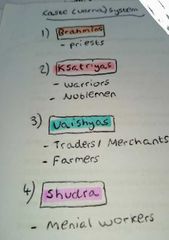
Socio-economic & political organisation.
1) Brahmins- Priests 2) Ksatriyas- Warriors & Noblemen 3) Vaishyas- Traders/ Merchants & Farmers 4) Shudras- menial workers
Untouchables- (Considered outside the caste system) homeless |
|
|
Lumbini |
Place where Queen Maya gave birth to Siddhartha Gautama. |
|
|
Kapilavastu |
Place where the Buddha Siddhartha grew up. |
|
|
Benares: Deer park |
Place where Buddha Siddhartha gave his first teaching which was The Four Noble Truths |
|
|
Bodh Gaya |
Place where the Buddha Siddhartha became enlightenment under the Bodh Gaya tree and defeated Mara. |
|
|
Kushinagar/ Kusinara |
Place where the Buddha Siddhartha passed away. |
|
|
Layout of the Buddha's life (The 10 Acts): |
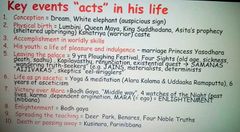
|
|
|
Image of the Buddha |
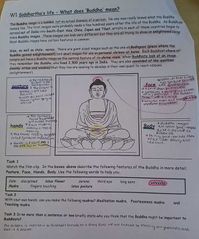
|
|
|
Why might the Life of the Buddha not be important to some Buddhists? |
-His teachings will help you free your mind, not the Buddha himself.
-Worshiping and focusing too much on the Buddha will cause attachment.
-In some traditions other Buddha's are more important (e.g, Amida Buddha in Pure Land).
-Self-reliance is an important step to enlightenment and focusing on the Buddha does not do this.
-The Buddha has not lived in the modern world so doesn't become very relevant to us anymore.
-The Buddha is no longer alive and can lead to disappointment that we can never meet him.
-Zen Buddhism is iconoclastic (No images). |
|
|
What do the Stories of Angulimala, Sunita and & Devadatta teach us? |
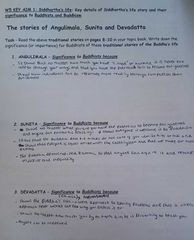
|
|
|
Map of the Buddha's life: |
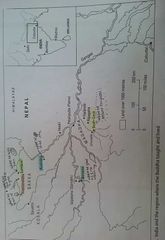
|
|
|
Origins of Hinduism |

|
|
|
Ahimsa |
Non-violence. |
|
|
Dhamma/Dharma |
Several meanings need to be distinguished:
1) In the Abhidhamma 'an impersonal momentary event or phenomenon' the smallest building-block of experience.
2) In Hinduism: duty, the right conduct for one's own caste and situation (which varies in each caste but forms part of a whole system). 3) In Buddhism: The truth, the teaching (of the Buddha), any true religious teaching.
|
|
|
Brahman |
The monotheistic God of Hinduism, unifying all other gods and part of the structure of the universe, ridiculed by Buddhism as Brahma-Sahampati. |
|
|
Bhrama |
Creator god in Hinduism. |
|
|
Brahmans/Brahmins |
The priestly caste of Hinduism. |
|
|
Brahmin |
Priest in Vedic and Hindu religion and society. |
|
|
Brahminism/ Brahmanism |
The religion of elaborate ritual preformed by Brahmins/Brahmans. |
|
|
Buddha |
'Awakened one'
1) A person who has achieved enlightenment.
2) The Buddha, Siddhartha Gautama, sometimes referred to as 'The Historical Buddha', the founder of Buddhism.
3) A mythical or symbolic figure representing the idea of enlightenment. |
|
|
Buddhism |
A Western name for the religious tradition which began with the Buddha. Buddhists themselves usually refer to this as the Dharma. |
|
|
Law of Dharma (B & H) |
One's religious duty to conform to one's social status (sva-dharma) which is determined at birth by God (Brahman). -Violation of Dharma can lead to bad kamma. -Fulfilling one's sva-dharma leads to a more favourable rebirth within the caste system. - kamma (for B&H)= divinely ordained duty (e.g, your caste) |
|
|
Deva (single/plural) |
One of the gods found in the realm of Gods in the Tibetan Wheel of Life. Theses are not worshipped by Buddhists but just considered to be beings caught up in very refined experiences. |
|
|
Devas |
Pantheon of Vedic and Hindu gods. |
|
|
Devi (Single/plural) |
Goddess ( female version of Deva). |
|
|
Dharmachaka |
The Wheel of the Dhamma: A symbol used for the Buddha and his teaching, and also associated with the Chakravartin or Wheel-turning monarch. -Also a name for a Mundra which symbolises teaching. |
|
|
Duhkha/ Dukkha |
Teaching that the universe has a basically unsatisfactory nature. |
|
|
Enlightenment |
Gaining all knowledge of the truths and reaching Nibbana/Nirvana. |
|
|
Guru |
A religious teacher. |
|
|
Hinduism |
Name invented by Westerners for a wide range of Indian religious traditions which follow on from Vedic religion. What we call Hinduism includes everything from the worship of local village gods to profound Philosophy, but it is bound together by the caste system and by monism. |
|
|
Iconoclasm |
A view that religious images can have negative effects, which sometimes involves destroying them. (adj. Iconoclastic). Kohan example- 'see a Buddha on the road, kill it'. |
|
|
Jainism |
Indian religion that began around the same time as Buddhism. Founded by Mahavira and still in existence today. It differs fundamentally from Buddhism in believing that the consequences of actions, not the motives behind them, produce kamma. |
|
|
Jataka |
'Birth story': Story of one of the Buddha's former lives. A collection of Jatakas forms one element of the Tripitaka. |
|
|
Kamma/ karma |
Literally 'Action' but usually used to mean karma-Vipaka or 'The fruits of action': This basically means the effects that all our actions (or more strictly, the motives for them) have on our future by setting up habits or patterns of behaviour. An enlightened person is free from karmic effects. |
|
|
Kshatriya |
Class of rulers and warriors to which the Buddha belonged to. |
|
|
Mara |
'Death': Symbolic character representing the forces working against enlightenment, who is depicted as trying to scare and then lure the Buddha from his purpose as he came close to Nibbana. |
|
|
Mantra |
Ritual chant preformed during ritual sacrifice and meditation. |
|
|
Moksha |
State of liberation from samsara and becoming one with God completely (Hinduism). |
|
|
Meditation |
Practice found in Buddhism and other religions, consisting of some kind of systematic mental exercise to change and improve habital mental states. There are numourous types meditation practice in the Buddhist tradition, divided into Samantha and Vipassana. |
|
|
Monism |
The cosmos consists of only one, essential principle. |
|
|
Nibbana/ Nirvana |
'Blowing out' (of flames of greed, hatred and ignorance). State first achieved by the Buddha which is the goal of all Buddhist practice, usually translated as 'enlightenment'. Nibbana is not a place or an after-death state (see Parinirvana,) but a fully awakened state of mind. As a principle, Nibbana is distinguished from its opposite, Samsara: The unenlightened universe. |
|
|
The Four Noble Truths |
The basic statement of the Buddha's teachings made in his first sermon after enlightenment. 1) Dukkha 2) The arising of Dukkha 3) The cessation of Dukkha 4) The path leading to the cessation of Dukkha |
|
|
Parinibbana/ Parinirvana |
The state after death of a person who gained Nibbana during life. Such a person will not be reborn and has obtained freedom from the Wheel of Life. In what sense he/she exists is an unanswerable mystery. |
|
|
Polytheism |
Belief in many gods. |
|
|
Pratityasamutpada/ Paticcasamuppada |
Variously translated as 'Dependent Origination' or 'Conditioned Co-production': The chain of causes and effects depicted around the edge of the Wheel of Life, which cause all phenomena to arise and blind us with continued unenlightened existence. |
|
|
Rebirth |
Traditional Buddhist belief that the process of Kamma associated with one individual goes on to be associated with a new individual after death. This should be clearly distinguished from reincarnation, the teaching that there is an immortal soul which passes from one body to another. There is no Immortal soul (anatta). |
|
|
Samsara |
The unenlightened state and the cyclic processes in the universe which perpetuate it. The opposite of Nibbana. |
|
|
Sanskrit |
Ancient Indian religious language. Similar with Latin in our language which all modern Indian languages are based from. |
|
|
Sceptic |
A person who doubts all truths and regards all doctrine as questionable. |
|
|
Shiva |
Vedic & Hindu god, destroys the cosmos. |
|
|
Shramana (single)/ Samana (Plural) |
Wandering holy man who has 'gone fourth' from the household life and seeks the the truth beyond conventional religion. There were many such holy men of different types at the time of the Buddha. |
|
|
Shudra |
Lowest class in the caste system: The servant class. |
|
|
Symbol |
Concrete image which represents something abstract, especially an idea not easily described in words (e.g, the Buddha is a symbol of enlightenment). |
|
|
Vaisha |
Second caste in Verdic and Hindu society: Trader/Merchants & Farmer class. |
|
|
Vedas |
Four ancient scriptures (the oldest known religious scriptures) which form the basis of the Vedic religion which preceded Hinduism: The contain mainly elaborate instructions for sacrifices and gyms in praise of ancient gods. |
|
|
Vishnu |
Vedic and Hindu god, sustains the universe. |
|
|
Unpanishads |
Philosophical teachings of Hinduism. |
|
|
The Buddha's 'Ten Acts' |
Ten acts describing Siddhartha's entire life before he became the Buddha. 1) Conception 2) physical birth 3) Accomplishments in worldly skills 4) His youth: A life of pleasure and indulgence 5) leaving the place 6) life as an ascetic 7) Victory over Mara 8) Enlightenment 9) Spreading the teaching 10) Death or passing away |
|
|
Namaste |
A Hindu greeting: 'The God (or soul) part in me is meeting the God (or soul) part of you. |

